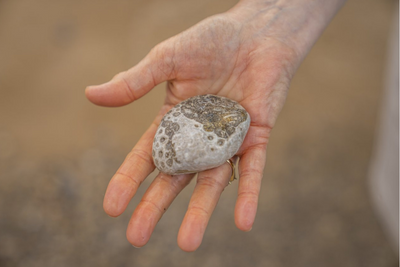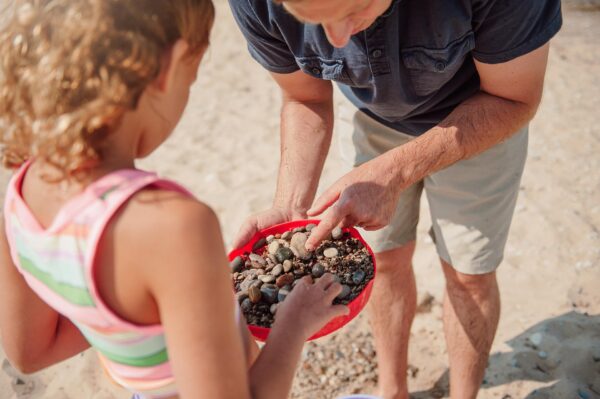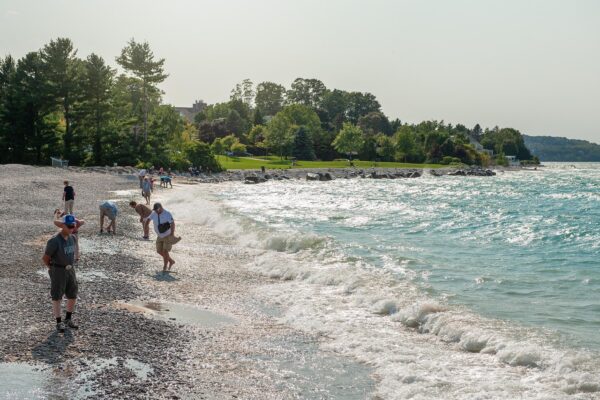Petoskey Stone
The Prehistoric Fossil Rocks
Well before dinosaurs roamed the earth, over 350 million years ago during the Devonian period, the land we know as Michigan was located near the equator. Covered by a warm, shallow, saltwater sea, the colonial coral hexagonaria percarinata thrived with other marine life in tropical reefs. The earth’s plates moved and pushed Michigan north to the 45th parallel and above sea level, which created dry land formations. More recently, about two million years ago, glacial action scraped the earth and spread the fossils across the northern Lower Peninsula, depositing major concentrations in the Petoskey area. The prehistoric fossil, unique to the Traverse Group rock strata, is called the Petoskey Stone and it became Michigan’s official state stone in 1965.

Name that Hexigonaria Percarinata
Hexagonaria percarinata consists of tightly packed, six-sided corallites, which are the skeletons of the once-living coral polyps. The center of each polyp was the mouth and contained tentacles that reached out for food. The hexagon shape of each cell and thin lines radiating out from the dark “eye” in the center are distinguishing features unique to this fossil. In a roundabout way they also helped determine its common name, Petoskey.
Pet-O-Sega, which means “Rays of the Rising Sun” in the Ottawa language, was the birth name given in 1787 to the son of a French fur trader and his Indian wife. Pet-O-Sega grew up in an area northwest of present day Harbor Springs, became a respected landowner and businessman and, like his father, was recognized as an Ottawa Indian Chief. In 1873 the settlement on the Bear River was named Petoskey in his honor.
Petoskey became a summertime destination for Victorian tourists and the unusual fossil specimens were popular souvenirs. Study the Petoskey Stone and you’ll see in each cell the pattern of the “rays of the rising sun,” a romantic tie to the origins of the resort area. Besides, “I’m bringing you a Petoskey Stone” was much easier to fit on a postcard than, “Wait until you see the Hexagonaria Percarinata I got you.”
In June of 1965 the Petoskey Stone was named Michigan’s official State Stone and Miss Ella Jane Petoskey, the only living grandchild of Chief Petoskey, attended the formal signing. In the city that bears his name, a bronze statue of the dashing Petoskey stands on a bluff overlooking Little Traverse Bay.
Petoskey Stone Hunting Tips
The most popular place for hunting Petoskey Stones is a Lake Michigan beach, and many say the best time of year is spring, after the sheets of ice have churned things up and uncovered specimens that they’ve pushed against the shore. That said, the rockhounding is good from the springtime thaw until the snow flies late in the year.
Although the beaches are the hot spots, those ancient glaciers spread the fossils around the area and rockhounds know to leave the lakeshore to search cut roadbeds, gravel pits and even farmer’s fields. (It’s important to respect property lines and gain permission to hunt on restricted and private land.)
Dry Petoskey Stones usually look like ordinary limestone in a color range from light grey to dark grey. The distinctive, six-sided “rays of the rising sun” pattern pops when the rock’s surface is wet, which is why it’s easier to spy Petoskey Stones along the shore or by wading out into the water.
Note: Keep an eye out for the rare “Pink Pets” Petoskey Stones. The pink hue is a result of the iron that permeated the coral as it calcified.
If you’re hunting in a dry area carry a water bottle to spray likely candidates to bring out that pattern. Get some great tips from the one of our local rock hounds.

Where to Rock On
Petoskey State Park: With two miles of shoreline on Little Traverse Bay (and Lake Michigan), this is a natural for novices as well as experienced rockhounds. Located on 303 acres between Petoskey and Harbor Springs off Hwy. M-119. Recreation passport required for entry.
Magnus City Park Beach: Easy access to the waterfront and Petoskey Stone hunting at this park with 1,000 feet of beach for rockhounding.
Solanus Mission Beach – West Bayfront Park: This provides access of 500 feet of beach/lakeshore for rock picking via the Wheelway or the Bayfront West Parking Lot.
Area Retailers: No time to hunt? Several local shops sell polished and unpolished stones with polishing kits, as well as beautiful jewelry, door knobs, wine stoppers and other gift items made from Petoskey Stones.

Solanus Mission Beach in West Bayfront Park
Photo credit: Michigan Barefoot Memories

